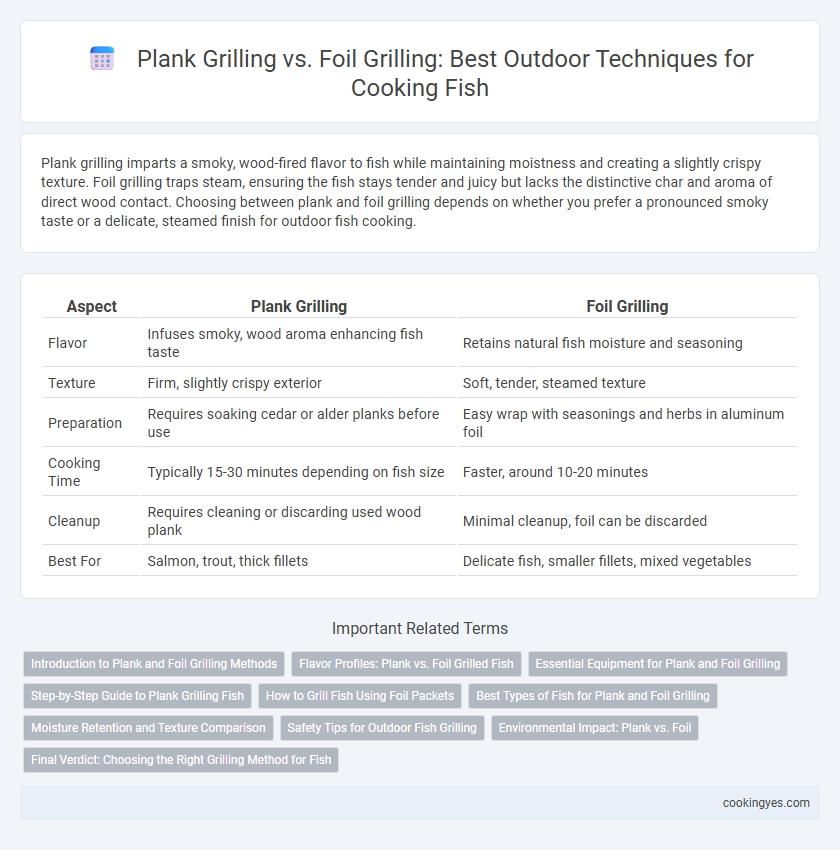Plank grilling imparts a smoky, wood-fired flavor to fish while maintaining moistness and creating a slightly crispy texture. Foil grilling traps steam, ensuring the fish stays tender and juicy but lacks the distinctive char and aroma of direct wood contact. Choosing between plank and foil grilling depends on whether you prefer a pronounced smoky taste or a delicate, steamed finish for outdoor fish cooking.
Table of Comparison
| Aspect | Plank Grilling | Foil Grilling |
|---|---|---|
| Flavor | Infuses smoky, wood aroma enhancing fish taste | Retains natural fish moisture and seasoning |
| Texture | Firm, slightly crispy exterior | Soft, tender, steamed texture |
| Preparation | Requires soaking cedar or alder planks before use | Easy wrap with seasonings and herbs in aluminum foil |
| Cooking Time | Typically 15-30 minutes depending on fish size | Faster, around 10-20 minutes |
| Cleanup | Requires cleaning or discarding used wood plank | Minimal cleanup, foil can be discarded |
| Best For | Salmon, trout, thick fillets | Delicate fish, smaller fillets, mixed vegetables |
Introduction to Plank and Foil Grilling Methods
Plank grilling infuses fish with smoky flavor by placing it on a soaked wooden plank directly over heat, preserving moisture and adding a subtle, aromatic essence. Foil grilling involves wrapping fish tightly in aluminum foil to lock in moisture and steam the fish, creating a tender texture while preventing direct exposure to flames. Both methods enhance outdoor fish cooking by offering distinct flavor profiles and moisture retention techniques.
Flavor Profiles: Plank vs. Foil Grilled Fish
Plank grilling infuses fish with smoky, woody flavors as the heat slowly penetrates the wooden surface, enhancing natural oils and creating a delicate charred aroma. Foil grilling preserves moisture and intensifies the fish's pure, fresh taste without adding external smoky notes, making it ideal for delicate or thin fillets. The choice between plank and foil grilling significantly influences flavor complexity, with plank grilling offering a nuanced, robust profile and foil grilling delivering clean, subtle taste.
Essential Equipment for Plank and Foil Grilling
Plank grilling requires a seasoned cedar or hardwood plank, a grill with adjustable heat zones, and a grill-safe brush to maintain plank integrity and flavor infusion. Foil grilling demands heavy-duty aluminum foil, a heat-resistant glove, and a sturdy grilling basket to ensure even cooking and easy handling of delicate fish. Both methods benefit from a reliable meat thermometer to monitor fish doneness without overcooking.
Step-by-Step Guide to Plank Grilling Fish
Plank grilling fish involves soaking a wooden plank, typically cedar, for at least one hour before placing seasoned fish fillets on it, allowing the wood to impart a smoky flavor while preventing overcooking. Heat the grill to medium temperature (around 350degF) and position the plank directly on the grates, cooking for 10-15 minutes until the fish flakes easily with a fork. Unlike foil grilling, plank grilling enhances moisture retention and imparts a subtle smoky essence, creating a tender, flavorful outdoor fish dish.
How to Grill Fish Using Foil Packets
Grilling fish using foil packets preserves moisture and prevents delicate fillets from sticking to the grill grates, enhancing flavor retention and texture. To prepare, place seasoned fish fillets and aromatics like lemon slices and herbs onto a large piece of heavy-duty aluminum foil, then seal tightly to create a steam pocket. Cook the foil packet over medium heat for 10 to 15 minutes, depending on fish thickness, ensuring even cooking and easy cleanup while avoiding flare-ups common with direct grilling methods.
Best Types of Fish for Plank and Foil Grilling
Salmon, trout, and striped bass are ideal for plank grilling due to their firm texture and rich flavor, which absorbs the smoky aroma from cedar, maple, or alder planks. Foil grilling suits delicate fish like tilapia, sole, and flounder, as it locks in moisture and prevents flaky flesh from falling apart over direct heat. Both methods enhance flavor but selecting the right fish type maximizes tenderness and taste during outdoor cooking.
Moisture Retention and Texture Comparison
Plank grilling enhances moisture retention by allowing the fish to cook slowly over indirect heat, absorbing smoky flavors while preventing dryness. Foil grilling traps steam directly around the fish, which preserves juiciness but can result in a softer, sometimes less crispy texture. Choosing plank grilling delivers a firmer, more textured exterior, whereas foil grilling ensures a tender and moist finish ideal for delicate fish varieties.
Safety Tips for Outdoor Fish Grilling
When grilling fish outdoors, using foil helps prevent flare-ups and reduces the risk of fish sticking, making it a safer option for maintaining controlled heat and avoiding burns. Plank grilling, while flavorful, requires careful monitoring to prevent the wood from catching fire, and users should keep a spray bottle of water nearby to manage any unexpected flames. Always ensure the grill is clean and stable, and handle fish with proper tools like tongs or spatulas to avoid accidents during cooking.
Environmental Impact: Plank vs. Foil
Plank grilling uses natural wooden boards that are biodegradable and sourced from sustainable forests, minimizing environmental waste compared to aluminum foil, which is energy-intensive to produce and challenging to recycle effectively. Foil often ends up in landfills due to contamination with food residue, whereas wooden planks decompose naturally without releasing harmful toxins. Choosing plank grilling reduces reliance on non-renewable resources and supports eco-friendly outdoor cooking practices.
Final Verdict: Choosing the Right Grilling Method for Fish
Plank grilling imparts a smoky, aromatic flavor to fish while keeping it moist through indirect heat, making it ideal for delicate fillets and whole fish. Foil grilling locks in moisture and allows for easy seasoning, perfect for quick-cooking fish or when cooking over direct flames. Selecting the right method depends on desired flavor complexity and cooking convenience, with plank grilling favored for enhanced taste and foil grilling preferred for ease and moisture retention.
Plank grilling vs foil grilling for outdoor fish cooking Infographic

 cookingyes.com
cookingyes.com